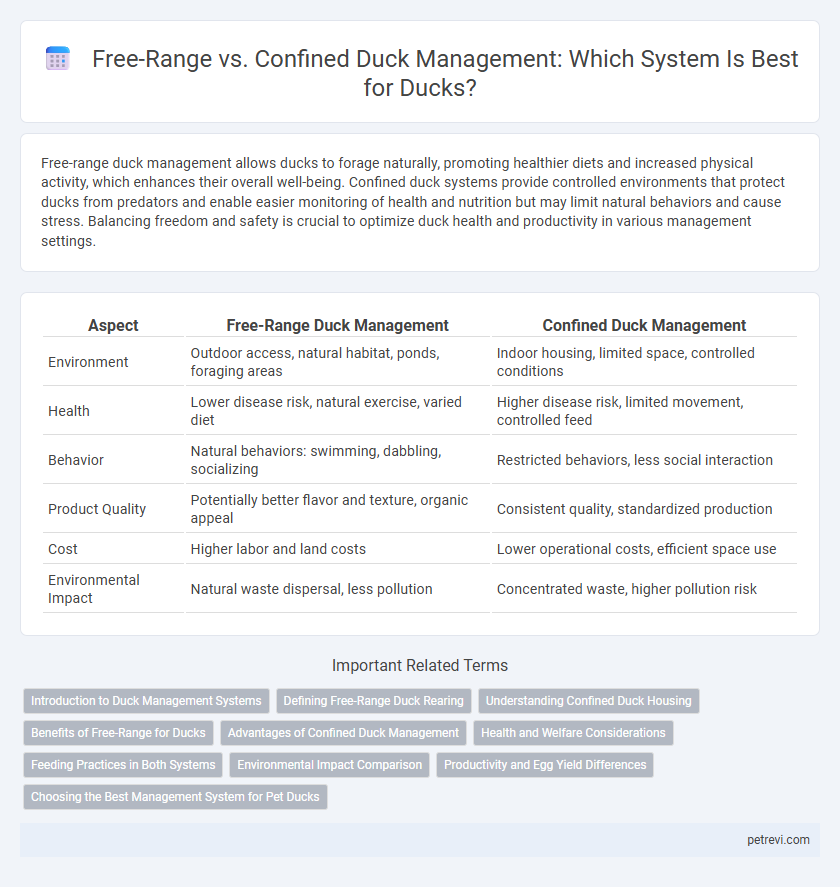Free-range duck management allows ducks to forage naturally, promoting healthier diets and increased physical activity, which enhances their overall well-being. Confined duck systems provide controlled environments that protect ducks from predators and enable easier monitoring of health and nutrition but may limit natural behaviors and cause stress. Balancing freedom and safety is crucial to optimize duck health and productivity in various management settings.
Table of Comparison
| Aspect | Free-Range Duck Management | Confined Duck Management |
|---|---|---|
| Environment | Outdoor access, natural habitat, ponds, foraging areas | Indoor housing, limited space, controlled conditions |
| Health | Lower disease risk, natural exercise, varied diet | Higher disease risk, limited movement, controlled feed |
| Behavior | Natural behaviors: swimming, dabbling, socializing | Restricted behaviors, less social interaction |
| Product Quality | Potentially better flavor and texture, organic appeal | Consistent quality, standardized production |
| Cost | Higher labor and land costs | Lower operational costs, efficient space use |
| Environmental Impact | Natural waste dispersal, less pollution | Concentrated waste, higher pollution risk |
Introduction to Duck Management Systems
Free-range duck management systems allow ducks to roam freely in natural environments, promoting better health and natural behaviors compared to confined systems that restrict movement in enclosed spaces. Confined duck management often involves controlled feeding, housing, and protection from predators, optimizing space but potentially increasing stress and disease risk. Choosing between free-range and confined methods depends on factors like production goals, resource availability, and animal welfare standards.
Defining Free-Range Duck Rearing
Free-range duck rearing involves allowing ducks to roam outdoors freely, accessing natural water sources like ponds or streams, which supports their innate behaviors and improves overall health. This management style contrasts with confined systems where ducks are restricted to indoor or enclosed spaces, limiting movement and natural foraging. Free-range practices enhance animal welfare, reduce disease risks, and promote sustainable duck farming by mimicking natural habitats.
Understanding Confined Duck Housing
Confined duck housing involves raising ducks in controlled environments that provide shelter, regulated temperature, and protection from predators, which enhances health management and reduces disease risks. This system allows precise control over feeding, lighting, and ventilation, optimizing growth rates and egg production. Proper design includes adequate space per bird, easy access to clean water, and effective waste management to maintain hygiene and prevent respiratory issues.
Benefits of Free-Range for Ducks
Free-range duck management promotes natural behaviors like foraging, swimming, and social interaction, improving overall duck welfare and reducing stress-related illnesses. Access to diverse outdoor environments enhances ducks' immune systems and supports optimal growth compared to confined systems. Free-range conditions also lead to higher-quality meat and eggs due to better nutrition and reduced exposure to overcrowding diseases.
Advantages of Confined Duck Management
Confined duck management offers advantages such as enhanced biosecurity by reducing exposure to predators and disease, leading to lower mortality rates. It allows precise control over feeding, ensuring optimal nutrition and faster growth, which improves overall productivity. Additionally, confined systems facilitate easier monitoring and waste management, minimizing environmental impact and promoting sustainable farming practices.
Health and Welfare Considerations
Free-range duck management promotes improved health and welfare by allowing natural behaviors such as foraging, swimming, and social interaction, which reduce stress and enhance immune function. Confined systems often restrict movement, increasing risks of disease transmission, respiratory issues, and behavioral problems like aggression or feather pecking. Optimizing environmental enrichment and space allocation in free-range settings supports overall duck well-being and performance.
Feeding Practices in Both Systems
Free-range duck management relies on natural foraging, allowing ducks to consume a diverse diet of insects, aquatic plants, and small fish, which enhances nutritional intake and supports natural behaviors. Confined systems depend on formulated feed pellets balanced for protein, vitamins, and minerals to ensure consistent growth and production, reducing the variability found in free-range diets. Optimizing feed quality and monitoring intake in both systems directly impacts duck health, growth rates, and overall productivity.
Environmental Impact Comparison
Free-range duck management significantly reduces environmental impact by allowing natural foraging, which lowers feed waste and promotes soil health through natural fertilization. In contrast, confined duck systems concentrate waste, increasing water contamination risks and requiring more intensive resource inputs. Sustainable free-range practices contribute to biodiversity and reduce the carbon footprint compared to conventional confined operations.
Productivity and Egg Yield Differences
Free-range ducks typically exhibit higher productivity and egg yield due to increased access to natural foraging, which enhances their overall health and nutrient intake. Confined duck systems often result in lower egg production rates but allow for easier management and protection from predators. Optimizing environmental conditions and diet in both systems is crucial to maximizing egg yield and ensuring sustainable duck farming practices.
Choosing the Best Management System for Pet Ducks
Free-range duck management promotes natural behaviors, improved health, and enhanced welfare by allowing ducks to forage freely in open spaces. Confined systems, while easier to control and protect from predators, can lead to increased stress and health issues if not properly maintained. Choosing the best system for pet ducks depends on balancing safety, space availability, and the owner's ability to provide environmental enrichment and proper care.
Free-Range vs Confined for Duck Management Infographic

 petrevi.com
petrevi.com